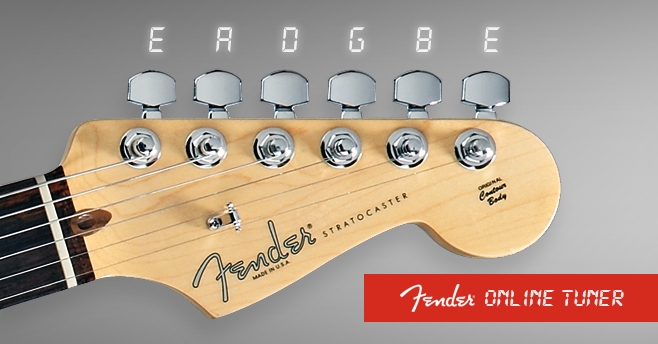Guitar Tuning Tips

As a beginner guitarist one of the first things you need to learn is how to tune the guitar. Unlike a piano which is only tuned once a year or so the guitar usually needs to be tuned every time you pick it up to play. This is due to the fact the stings and the neck of the instrument are easily effected by changes in temperature and humidity with them expanding and shrinking in changes in the environment. Also it can be easy to knock the tuning pegs if you’re carrying your guitar in a gig bag etc.
The Notes of Music
The music alphabet consists of the notes A B C D E F G which then simply repeat starting again at the A note as you go higher in pitch. These notes are the same for all instruments in western music so if you are playing an A note on the guitar it will sound the same pitch on the piano, violin and many other instruments.
The 6 strings of the guitar are tuned to 6 different notes with the lowest in pitch (thickest and closest to the ceiling) being the 6th string and the highest in pitch (thinnest and closest to the floor) being the 1st string. This can be a bit confusing as what is known as the top or high E string is actually the string closest to the floor!
The trick to learning and remembering the string notes is this:
6.Eddy 5.Ate 4.Dynamite 3.Good 2.Bye 1.Eddy
This is called “standard” tuning. There are many other ways of tuning the guitar but for most songs this tuning will do the job.
Electronic Guitar Tuner
An electronic guitar tuner will help you to easily tune the strings of the guitar to the correct notes. The tuner will show a needle that will be placed in the middle when the string is in tune. Some tuners have a microphone to pick up the sound of the note while other clip-on guitar tuners attach to the guitar headstock and pick up the vibration of the string when it’s plucked.
Tuning The Guitar With An Electronic Tuner
Now that we know what notes the strings should be tuned to we can tune the guitar. For beginners it is highly recommended to use an electronic guitar tuner.
When using the electronic tuner pluck the open string and let it ring out for as long as possible for the tuner to work out what the note is. Once you can see the needle being displayed on the tuner tighten or loosen the string as required until the needle is in the middle of the display. Also make sure that you’re tuning to the correct note for the string as it’s easy to tune a G string to G# (one note up from G) if you’re not reading the display on the tuner correctly.
Tuning The Guitar With Your Ear
You can also tune the guitar using just your ear or aurally. This is done by tuning one string to another. The 5th fret note on the 6th (low thick E string) is A which is the same pitch as the open 5th string. Use the diagram below to see where these notes are on the strings to tune them with each other.
Tuning by ear can be difficult for beginners as it can take time to develop aural skills to determine when you are in tune and also importantly how far out of tune you are and whether you need to go up or down in pitch to make the two strings match. The video lesson below shows how this is done. However for beginners it is recommended to use an electronic tuner to be sure that you are in tune.
Also if you are tuning your guitar to the 6th string by ear you can get into trouble when playing with other musicians as the 6th string may not always be exactly tuned to E.
This is a small sample from the book Learning To Play The Guitar – An Absolute Beginners Guide now available at Amazon.com



